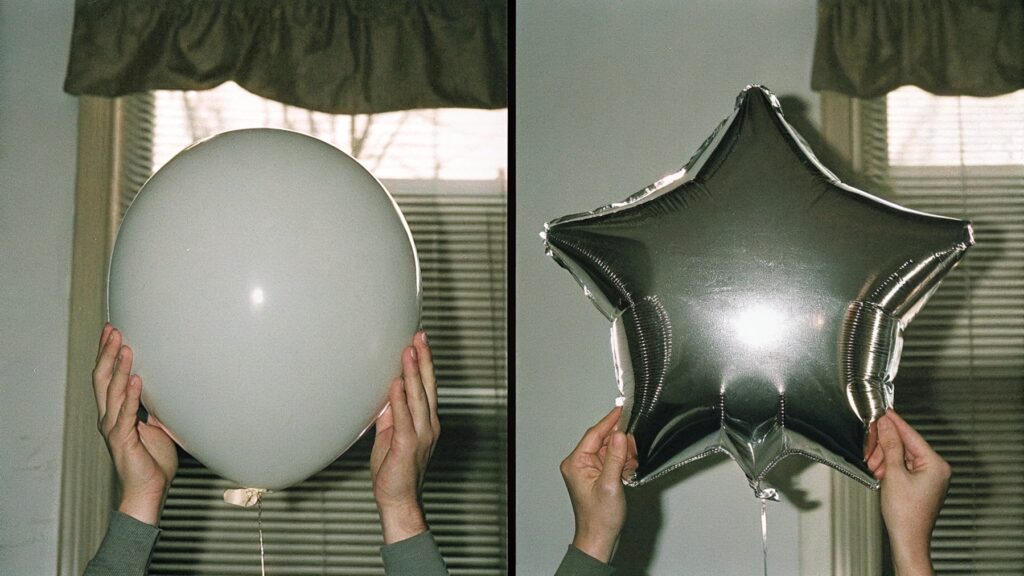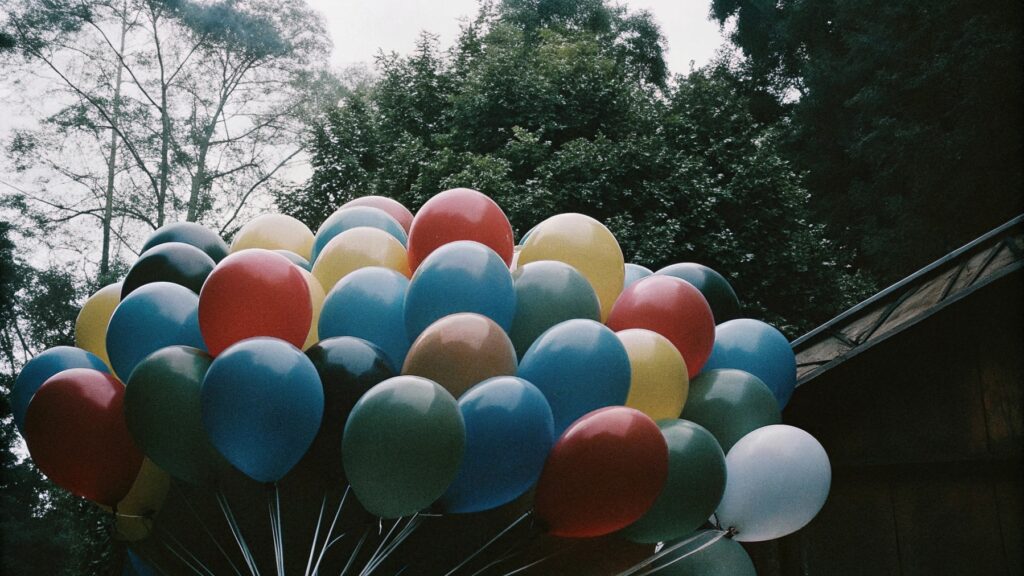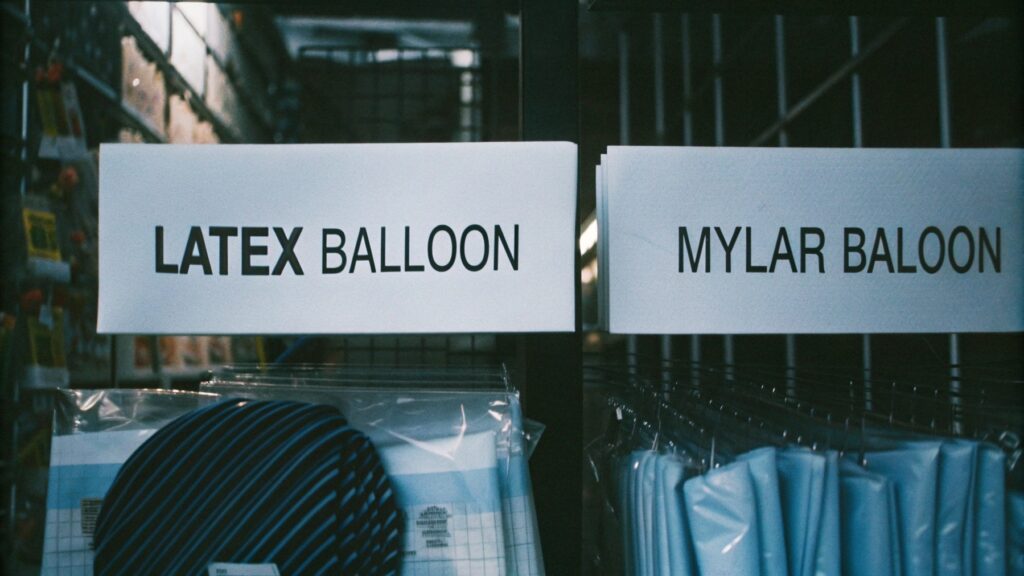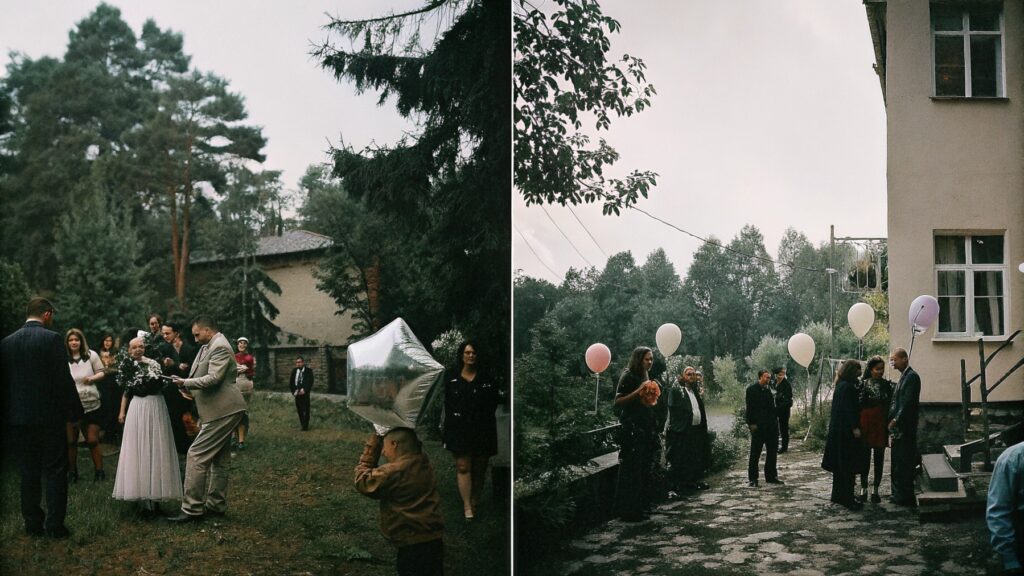What are the key differences between Latex and Mylar Balloons for resale?
Are you confused about which balloons to stock? Feeling pressure to meet customer demands? Need to know the real differences?
Latex and Mylar balloons differ in material, production, style, and environmental impact1. These differences affect durability, cost, and suitability2 for various uses, making them distinct choices for your business.

Choosing the right balloons for your business is important. It impacts your costs and customer satisfaction. Let's look at what makes Latex and Mylar different.
What makes latex balloons different from Mylar for your business?
Are you trying to figure out which balloon type fits your stock best? Worried about making the wrong choice for your customers? Wondering about the core differences?
Latex balloons are made from natural rubber, offering flexibility and biodegradability3. Mylar balloons are made from nylon covered with aluminum foil, providing longer float times and a metallic sheen.

Understanding the materials is the first step. This impacts everything else about the balloon. Let's see how these materials lead to different qualities.
Material Differences:
Latex balloons come from rubber trees. The liquid rubber is processed into sheets. These sheets are then shaped into balloons. It's a natural process. Mylar balloons are synthetic. They use a special film. This film is coated with metal.
| Feature | Latex Balloons | Mylar Balloons |
|---|---|---|
| Primary Material | Natural Rubber Latex | Nylon with Aluminum Coating |
| Origin | Tree Sap | Synthetic Film |
| Flexibility | High | Low |
| Texture | Soft, Matte (usually) | Smooth, Shiny |
| Stretchiness | Very Stretchy | Not Stretchy |
| Puncture | Can be punctured easily | More resistant to punctures |
This difference in material affects how the balloon feels and acts. Latex is soft and stretches. Mylar is stiff and shiny. Knowing this helps you decide how to use them. I remember when I first saw Mylar balloons. They felt so different from latex. It was clear they served different purposes.
Production Process:
Latex balloons are made by dipping molds into liquid latex. The latex dries on the mold. Then, the balloons are removed. It's a simple process. Mylar balloons are more complex. The film is cut into shapes. The edges are heat-sealed. This creates the balloon shape. A valve is added for inflation.
| Step | Latex Balloon Production | Mylar Balloon Production |
|---|---|---|
| Shaping Method | Mold Dipping | Film Cutting and Heat Sealing |
| Materials Used | Liquid Latex, Pigments | Nylon Film, Aluminum Coating |
| Joining Edges | One piece, naturally formed | Heat Sealing |
| Valve | Usually none (neck tied) | Integrated valve for inflation |
| Printing | Done after forming | Can be printed on the film |
The production process impacts the final product's quality and features. Dipping latex is faster for simple shapes. Heat-sealing Mylar allows for complex shapes. This affects the variety of designs available. It also impacts production speed and cost.
How does the durability of Mylar compare to Latex for wholesale buyers?
Are you concerned about balloon lifespan4 for your customers? Do you need balloons that last longer on display? Wondering which type is more robust for shipping and handling?
Mylar balloons are significantly more durable than Latex balloons. They resist punctures better and hold helium for much longer periods, making them ideal for extended displays and shipping.

Durability is key for wholesale. You want products that last. This means less waste and happier customers. Let's look at how long each type lasts.
Float Time:
Latex balloons float for a limited time. Typically, they float for 12-24 hours when filled with helium. Adding a special coating can extend this. But it's still shorter than Mylar. Mylar balloons float for days or even weeks. The film is less porous. Helium escapes much slower.
| Factor | Latex Balloons (Helium) | Mylar Balloons (Helium) |
|---|---|---|
| Typical Float | 12-24 hours (untreated) | Days to Weeks |
| Helium Loss | Relatively fast | Very slow |
| Treatment | Can be treated for longer float | No treatment needed for long float |
| Environmental | Affected by temperature change | Less affected by temperature |
| Usage | Best for short events | Best for long displays, gifts |
This difference is huge for events and gifts. If you need balloons to last for a week, Mylar is the only choice. For a single-day party, latex works fine. I remember a trade show where we used Mylar balloons. They stayed inflated the whole week, which was a great visual for visitors.
Puncture Resistance:
Latex balloons can pop easily. A sharp edge or too much pressure can cause them to burst. This makes them fragile during setup and transport. Mylar balloons are tougher. The nylon film is strong. It's much harder to puncture. They are more forgiving during handling.
| Feature | Latex Balloons | Mylar Balloons |
|---|---|---|
| Material Strength | Less strong | Much stronger |
| Sharp Objects | Easily popped by sharp things | More resistant to sharp things |
| Over-Inflation | High risk of bursting | Can still burst, but less likely |
| Handling | Needs careful handling | More robust handling |
| Usage | Careful decoration | Great for shipping and retail |
This means Mylar balloons are better for shipping. They are less likely to pop in transit. They are also better for busy retail environments. They can withstand more bumps and scrapes. I've seen latex balloons pop just from static electricity. Mylar rarely has that problem.
What are the cost considerations for stocking Latex vs. Mylar balloons?
Are you analyzing your budget for balloon inventory? Trying to find the most cost-effective options for different uses? Wondering if higher upfront cost means better long-term value?
Generally, Latex balloons have a lower per-unit cost than Mylar balloons. However, Mylar's longer float time and durability can offer better value for certain applications, reducing the need for replacements.

Cost is always important in wholesale. You need to balance price and value. Let's compare the costs of these balloon types.
Unit Price:
Latex balloons are cheaper to make. This means the cost per balloon is lower. You can buy many latex balloons for the price of a few Mylar ones. Mylar balloons use more expensive materials. The production process is also more complex. This makes the unit price higher.
| Factor | Latex Balloons | Mylar Balloons |
|---|---|---|
| Per-Unit Cost | Lower | Higher |
| Bulk Pricing | Very favorable for bulk | Less favorable for bulk |
| Material Cost | Lower raw material cost | Higher raw material cost |
| Production Cost | Simpler process, lower cost | More complex, higher cost |
| Entry Point | Low investment to stock | Higher initial investment |
This difference affects your inventory investment. You can stock a large variety of latex balloons cheaply. Stocking a similar variety of Mylar costs more. For businesses starting out, latex is often the easier entry point.
Value Over Time:
While Mylar costs more upfront, they last longer. This means they provide value over a longer period. A customer might use a Mylar balloon for a week. A latex balloon might last a day. For gifts or long events, Mylar's extended life adds value. For short parties, the lower cost of latex is better value.
| Factor | Latex Balloons (Value) | Mylar Balloons (Value) |
|---|---|---|
| Use Duration | Short-term events | Long-term displays, gifts |
| Replacements | May need replacement for long events | Rarely needs replacement |
| Per-Day Cost | Lower for very short periods | Lower for long periods |
| Customer View | Seen as disposable/party item | Seen as longer-lasting gift item |
| Storage Life | Can degrade over time (latex) | More stable storage life |
Consider the total cost of ownership or display. If a latex balloon needs helium refills or replacement, the cost goes up. Mylar holds helium better, reducing these costs. When I discuss options with customers, I always mention the float time vs. cost5. It helps them see the long-term value.
Which type of balloon, Latex or Mylar, is better for your target market?
Are you unsure which balloon type your customers prefer? Trying to match balloon features to specific occasions? Need to understand how different markets use balloons?
The best balloon type depends on your target market's needs and occasions. Latex is popular for parties and general decoration, while Mylar is preferred for gifts, long-term displays, and specific themes.

Knowing your customer is vital. What events do they buy for? What do they value? This helps you stock the right mix.
Occasion Suitability6:
Latex balloons are great for mass decoration. Think parties, events, and large gatherings. They are easy to tie into bunches and arches. They come in many colors and sizes. Mylar balloons are often used for gifts or special messages. They can be shaped like characters, numbers, or specific objects. They are perfect for birthdays, anniversaries, or sending a special wish.
| Occasion | Latex Balloon Use | Mylar Balloon Use |
|---|---|---|
| Parties | Decoration, games, general fill | Themed, character, special gifts |
| Events | Large-scale decor, arches, walls | Branded, message, focal points |
| Gifts | Less common as stand-alone gift | Very common, special shapes |
| Retail Display | General store decoration | Specific product promotion, themed |
| Holidays | General festive colors | Specific holiday themes, shapes |
Consider the typical use cases. If you serve many party planners, latex is essential. If your customers buy gifts, Mylar should be a focus. We see customers buying latex in bulk for festivals. They buy Mylar for specific celebrations.
Design and Customization:
Latex balloons offer basic shapes but a wide range of colors. They can be printed on, but the stretch can distort designs. Mylar balloons offer complex shapes and metallic finishes. They can be printed with high-quality images and detailed designs. This allows for licensed characters and specific themes.
| Feature | Latex Balloons Customization | Mylar Balloons Customization |
|---|---|---|
| Shapes | Standard rounds, ovals | Wide variety of custom shapes7 |
| Colors | Extensive range of solid colors | Metallic, iridescent, bright solids |
| Printing | Basic logos, simple text | High-quality images, complex designs |
| Finishes | Matte, Pearl, Metallic (less shiny) | Shiny, Metallic, Holographic |
| Special Features | Twisting balloons | Valves, integrated weights |
If your market wants specific cartoon characters or detailed logos, Mylar is usually the way to go. If they need simple, colorful decorations, latex is sufficient. My company invests in Mylar molds for popular characters because we know that's what many retailers need for their customers.
Environmental Considerations:
Latex balloons are made from a natural product8. They are biodegradable. This is important for environmentally conscious consumers9. Mylar balloons are made from plastic and aluminum. They are not biodegradable. They are often designed for reuse, which can reduce their impact if they are not discarded after one use.
| Factor | Latex Balloons (Environment) | Mylar Balloons (Environment) |
|---|---|---|
| Material | Natural, Renewable | Synthetic, Non-renewable |
| Biodegradability | Yes | No |
| Disposal | Decomposes naturally | Must be landfilled, can be recycled (rarely) |
| Reusability | Single-use generally | Can be deflated and reused |
| Consumer View | Often perceived as more eco-friendly | Perceived as less eco-friendly |
More customers are asking about the environmental impact. Stocking biodegradable options like latex can appeal to this market segment. It's a selling point that resonates with many consumers today. We make sure our customers know our latex is natural.
Conclusion
Choosing between Latex and Mylar balloons involves looking at materials, how they're made, their style, and environmental effects. Latex is cheaper and natural, good for parties, while Mylar lasts longer, offers more designs, and suits gifts, costing more.
-
Learning about the environmental impact can enhance your business's sustainability practices and appeal to eco-conscious customers. ↩
-
Exploring these factors will guide you in selecting the right balloons for your business needs and customer preferences. ↩
-
Learn about the significance of biodegradability in balloon materials to make environmentally conscious choices for your business. ↩
-
Learn about the lifespan differences between Latex and Mylar balloons to make informed choices for your customers' needs. ↩
-
Learn how float time impacts balloon costs to better advise customers on their options and maximize value ↩
-
Learn about the importance of occasion suitability in balloon selection to ensure your events are perfectly decorated. ↩
-
Discover innovative custom balloon shapes that can enhance your event's decor and make it memorable. ↩
-
Discover the advantages of natural products, which can help you make informed choices for eco-friendly options. ↩
-
Learn strategies to attract environmentally conscious consumers, a growing market segment that values sustainability. ↩
